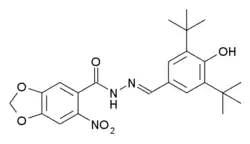LASSBio-881 |
|
N'-[(3,5-ditert-butyl-4-oxocyclohexa-2,5-dien-1-ylidene)methyl]-6-nitro-1,3-benzodioxole-5-carbohydrazide
|
| CAS Number | |
|---|
| PubChem CID | |
|---|
| ChemSpider | |
|---|
| ChEMBL | |
|---|
|
| Formula | C23H27N3O6 |
|---|
| Molar mass | 441.484 g·mol−1 |
|---|
| 3D model (JSmol) | |
|---|
Oc1c(C(C)(C)C)cc(cc1C(C)(C)C)\C=N\NC(=O)c2cc3OCOc3cc2[N](=O)=O
|
InChI=1S/C23H27N3O6/c1-22(2,3)15-7-13(8-16(20(15)27)23(4,5)6)11-24-25-21(28)14-9-18-19(32-12-31-18)10-17(14)26(29)30/h7-11,27H,12H2,1-6H3,(H,25,28)/b24-11+ Key:XEYZVZBNMMRXSN-BHGWPJFGSA-N
|
LASSBio-881 is a drug which acts as both a non-selective partial agonist of the CB1 and CB2 cannabinoid receptors, and also as an antagonist of the TRPV1 receptor, as well as having antioxidant effects. It has potent anti-inflammatory and anti-hyperalgesic effects in animal studies.[1][2]
- LASSBio-945 has an identical structure sans the nitro FG.
References
- ^ Duarte CD, Tributino JL, Lacerda DI, Martins MV, Alexandre-Moreira MS, Dutra F, et al. (March 2007). "Synthesis, pharmacological evaluation and electrochemical studies of novel 6-nitro-3,4-methylenedioxyphenyl-N-acylhydrazone derivatives: Discovery of LASSBio-881, a new ligand of cannabinoid receptors". Bioorganic & Medicinal Chemistry. 15 (6): 2421–33. doi:10.1016/j.bmc.2007.01.013. PMID 17275312.
- ^ Tributino JL, Santos ML, Mesquita CM, Lima CK, Silva LL, Maia RC, et al. (April 2010). "LASSBio-881: an N-acylhydrazone transient receptor potential vanilloid subfamily type 1 antagonist orally effective against the hypernociception induced by capsaicin or partial sciatic ligation". British Journal of Pharmacology. 159 (8): 1716–23. doi:10.1111/j.1476-5381.2010.00672.x. PMC 2925494. PMID 20401963.
|
|---|
Phytocannabinoids
(comparison) | | Cannabibutols | |
|---|
| Cannabichromenes | |
|---|
| Cannabicyclols | |
|---|
| Cannabidiols | |
|---|
| Cannabielsoins | |
|---|
| Cannabigerols | |
|---|
| Cannabiphorols | |
|---|
| Cannabinols |
- CBN
- CBNA
- CBN-C1
- CBN-C2
- CBN-C4
- CBNM
- CBND
- CBNP
- CBVD
|
|---|
| Cannabitriols | |
|---|
| Cannabivarins | |
|---|
| Delta-3-tetrahydrocannabinols | |
|---|
| Delta-4-tetrahydrocannabinols | |
|---|
| Delta-7-tetrahydrocannabinols | |
|---|
| Delta-8-tetrahydrocannabinols | |
|---|
| Delta-9-tetrahydrocannabinols | |
|---|
| Delta-10-Tetrahydrocannabinols | |
|---|
| Delta-11-Tetrahydrocannabinols | |
|---|
| Miscellaneous cannabinoids | |
|---|
| Active metabolites | |
|---|
|
|---|
| Endocannabinoids | |
|---|
Synthetic
cannabinoid
receptor
agonists /
neocannabinoids | Classical cannabinoids
(dibenzopyrans) | |
|---|
Non-classical
cannabinoids | |
|---|
| Adamantoylindoles | |
|---|
| Benzimidazoles | |
|---|
| Benzoylindoles | |
|---|
| Cyclohexylphenols | |
|---|
| Eicosanoids | |
|---|
Indazole-3-
carboxamides | |
|---|
| Indole-3-carboxamides | |
|---|
| Indole-3-carboxylates | |
|---|
| Naphthoylindazoles | |
|---|
| Naphthoylindoles | |
|---|
| Naphthoylpyrroles | |
|---|
| Naphthylmethylindenes | |
|---|
| Naphthylmethylindoles | |
|---|
| Phenylacetylindoles | |
|---|
| Pyrazolecarboxamides | |
|---|
Tetramethylcyclo-
propanoylindazoles | |
|---|
Tetramethylcyclo-
propanoylindoles | |
|---|
| Others | |
|---|
|
|---|
| Allosteric CBRTooltip Cannabinoid receptor ligands | |
|---|
Endocannabinoid
enhancers
(inactivation inhibitors) | |
|---|
Anticannabinoids
(antagonists/inverse
agonists/antibodies) | |
|---|
|
